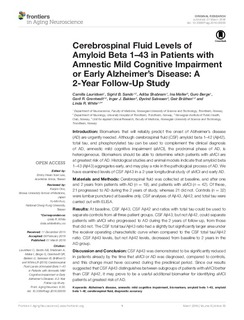| dc.contributor.author | Lauridsen, Camilla | |
| dc.contributor.author | Sando, Sigrid Botne | |
| dc.contributor.author | Shabnam, Adiba | |
| dc.contributor.author | Møller, Ina | |
| dc.contributor.author | Berge, Guro | |
| dc.contributor.author | Grøntvedt, Gøril Rolfseng | |
| dc.contributor.author | Bakken, Inger Johanne | |
| dc.contributor.author | Salvesen, Øyvind | |
| dc.contributor.author | Bråthen, Geir | |
| dc.contributor.author | White, Linda | |
| dc.date.accessioned | 2016-05-23T11:45:52Z | |
| dc.date.accessioned | 2016-06-02T13:09:42Z | |
| dc.date.available | 2016-05-23T11:45:52Z | |
| dc.date.available | 2016-06-02T13:09:42Z | |
| dc.date.issued | 2016 | |
| dc.identifier.citation | Frontiers in Aging Neuroscience 2016, 8 | nb_NO |
| dc.identifier.issn | 1663-4365 | |
| dc.identifier.uri | http://hdl.handle.net/11250/2391254 | |
| dc.description.abstract | Introduction: Biomarkers that will reliably predict the onset of Alzheimer’s disease (AD) are urgently needed. Although cerebrospinal fluid (CSF) amyloid beta 1–42 (Aβ42), total tau, and phosphorylated tau can be used to complement the clinical diagnosis of AD, amnestic mild cognitive impairment (aMCI), the prodromal phase of AD, is heterogeneous. Biomarkers should be able to determine which patients with aMCI are at greatest risk of AD. Histological studies and animal models indicate that amyloid beta 1–43 (Aβ43) aggregates early, and may play a role in the pathological process of AD. We have examined levels of CSF Aβ43 in a 2-year longitudinal study of aMCI and early AD.
Materials and Methods: Cerebrospinal fluid was collected at baseline, and after one and 2 years from patients with AD (n = 19), and patients with aMCI (n = 42). Of these, 21 progressed to AD during the 2 years of study, whereas 21 did not. Controls (n = 32) were lumbar punctured at baseline only. CSF analyses of Aβ43, Aβ42, and total tau were carried out with ELISA.
Results: At baseline, CSF Aβ43, CSF Aβ42 and ratios with total tau could be used to separate controls from all three patient groups. CSF Aβ43, but not Aβ42, could separate patients with aMCI who progressed to AD during the 2 years of follow-up, from those that did not. The CSF total tau/Aβ43 ratio had a slightly but significantly larger area under the receiver operating characteristic curve when compared to the CSF total tau/Aβ42 ratio. CSF Aβ43 levels, but not Aβ42 levels, decreased from baseline to 2 years in the AD group.
Discussion and Conclusion: CSF Aβ43 was demonstrated to be significantly reduced in patients already by the time that aMCI or AD was diagnosed, compared to controls, and this change must have occurred during the preclinical period. Since our results suggested that CSF Aβ43 distinguishes between subgroups of patients with aMCI better than CSF Aβ42, it may prove to be a useful additional biomarker for identifying aMCI patients at greatest risk of AD. | nb_NO |
| dc.language.iso | eng | nb_NO |
| dc.publisher | Frontiers Media | nb_NO |
| dc.relation.uri | http://www.ncbi.nlm.nih.gov/pmc/articles/PMC4772322/pdf/fnagi-08-00030.pdf | |
| dc.rights | Navngivelse 3.0 Norge | * |
| dc.rights.uri | http://creativecommons.org/licenses/by/3.0/no/ | * |
| dc.title | Cerebrospinal Fluid Levels of Amyloid Beta 1-43 in Patients with Amnestic Mild Cognitive Impairment or Early Alzheimer's Disease: A 2-Year Follow-Up Study | nb_NO |
| dc.type | Journal article | nb_NO |
| dc.type | Peer reviewed | nb_NO |
| dc.date.updated | 2016-05-23T11:45:52Z | |
| dc.source.volume | 8 | nb_NO |
| dc.source.journal | Frontiers in Aging Neuroscience | nb_NO |
| dc.identifier.doi | 10.3389/fnagi.2016.00030 | |
| dc.identifier.cristin | 1356933 | |
| dc.description.localcode | © 2016 Lauridsen, Sando, Shabnam, Møller, Berge, Grøntvedt, Bakken, Salvesen, Bråthen and White. This is an open-access article distributed under the terms of the Creative Commons Attribution License (CC BY). The use, distribution or reproduction in other forums is permitted, provided the original author(s) or licensor are credited and that the original publication in this journal is cited, in accordance with accepted academic practice. No use, distribution or reproduction is permitted which does not comply with these terms. | nb_NO |

